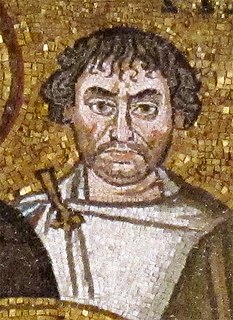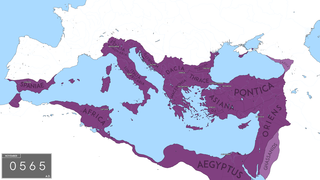
Justinian I, also known as Justinian the Great, was the Byzantine emperor from 527 to 565.
The 550s decade ran from January 1, 550, to December 31, 559.
The 570s decade ran from January 1, 570, to December 31, 579.

Year 552 (DLII) was a leap year starting on Monday of the Julian calendar. The denomination 552 for this year has been used since the early medieval period, when the Anno Domini calendar era became the prevalent method in Europe for naming years.

Narses was, with Belisarius, one of the great generals in the service of the Byzantine Emperor Justinian I during the Roman reconquest that took place during Justinian's reign. Narses was a Romanized Armenian. He spent most of his life as an important eunuch in the palace of the emperors in Constantinople.

Justin I was the Byzantine emperor from 518 to 527. Born to a peasant family, he rose through the ranks of the army to become commander of the imperial guard, and when Emperor Anastasius died he out-maneouvered his rivals and was elected as his successor, in spite of being almost 70 years old. His reign is significant for the founding of the Justinian dynasty that included his eminent nephew Justinian I and three succeeding emperors. His consort was Empress Euphemia.

Year 591 (DXCI) was a common year starting on Monday of the Julian calendar. The denomination 591 for this year has been used since the early medieval period, when the Anno Domini calendar era became the prevalent method in Europe for naming years.
Kamsarakan was an Armenian noble family that was an offshoot of the House of Karen, also known as the Karen-Pahlav. The Karens were one of the Seven Great Houses of Iran and were of Parthian origin.

The Gothic War between the East Roman (Byzantine) Empire during the reign of Emperor Justinian I and the Ostrogothic Kingdom of Italy took place from 535 until 554 in the Italian peninsula, Dalmatia, Sardinia, Sicily and Corsica. It was one of the last of the many Gothic Wars with the Roman Empire. The war had its roots in the ambition of the East Roman Emperor Justinian I to recover the provinces of the former Western Roman Empire, which the Romans had lost to invading barbarian tribes in the previous century.
Nerses is an Armenian variant of Narses. With the addition of -ian and -yan, it becomes an Armenian family name like Nersesian and Nersisyan.

The Chosroid dynasty, also known as the Iberian Mihranids, were a dynasty of the kings and later the presiding princes of the early Georgian state of Iberia from the 4th to the 9th centuries. The family, of Iranian Mihranid origin, accepted Christianity as their official religion c. 337, and maneuvered between the Byzantine Empire and Sassanid Iran to retain a degree of independence. After the abolition of the Iberian kingship by the Sassanids c. 580, the dynasty survived in its two closely related, but sometimes competing princely branches—the elder Chosroid and the younger Guaramid—down to the early ninth century when they were succeeded by the Georgian Bagratids on the throne of Iberia.
Artabanes was an East Roman (Byzantine) general of Armenian origin who served under Justinian I. Initially a rebel against Byzantine authority, he fled to the Sassanid Persians but soon returned to Byzantine allegiance. He served in Africa, where he won great fame by killing the rebel general Guntharic and restoring the province to imperial allegiance. He became engaged to Justinian's niece Praejecta, but did not marry her due to the opposition of the Empress Theodora. Recalled to Constantinople, he became involved in a failed conspiracy against Justinian in 548/549, but wasn't punished severely after its revelation. He was soon pardoned and sent to Italy to fight in the Gothic War, where he participated in the decisive Byzantine victory at Casilinum.

The Byzantine–Sasanian War of 572–591 was a war fought between the Sasanian Empire of Persia and the Eastern Roman Empire, termed by modern historians as the Byzantine Empire. It was triggered by pro-Byzantine revolts in areas of the Caucasus under Persian hegemony, although other events also contributed to its outbreak. The fighting was largely confined to the southern Caucasus and Mesopotamia, although it also extended into eastern Anatolia, Syria, and northern Iran. It was part of an intense sequence of wars between these two empires which occupied the majority of the 6th and early 7th centuries. It was also the last of the many wars between them to follow a pattern in which fighting was largely confined to frontier provinces and neither side achieved any lasting occupation of enemy territory beyond this border zone. It preceded a much more wide-ranging and dramatic final conflict in the early 7th century.

Adarnase I or Adrnerse, of the Chosroid dynasty, was a presiding prince of Iberia from 627 to 637/642.

Principality of Iberia was an early medieval aristocratic regime in a core Georgian region of Kartli, i.e. Iberia per classical authors. It flourished in the period of interregnum between the sixth and ninth centuries, when the leading political authority was exercised by a succession of princes. The principate was established shortly after the Sassanid suppression of the local royal Chosroid dynasty, around 580; it lasted until 888, when the kingship was restored by a member of the Bagrationi Dynasty. Its borders fluctuated greatly as the presiding princes of Iberia confronted the Persians, Byzantines, Khazars, Arabs, and the neighboring Caucasian rulers throughout this period.
Sittas was a Byzantine military commander during the reign of Emperor Justinian I. During the Iberian War against the Sassanid Empire, Sittas was given command of forces in Armenia, similar to the status of Belisarius in Mesopotamia. He won a victory over the Sassanids at the battle of Satala.

The Byzantine Empire had its first golden age under the Justinian Dynasty, which began in 518 AD with the Accession of Justin I. Under the Justinian Dynasty, particularly the reign of Justinian I, the Empire reached its greatest territorial extent since the fall of its Western counterpart, reincorporating North Africa, southern Illyria, southern Spain, and Italy into the Empire. The Justinian Dynasty ended in 602 with the deposition of Maurice and the ascension of his successor, Phocas.

The area of Georgia was under Roman control between the 1st century BC and the 7th century AD. This control varied by time and was intermittent over the kingdoms of Colchis and Iberia in the Caucasus region. These kingdoms roughly correspond to some of the western and eastern parts of modern Georgia.

Arab rule in Georgia refers to the period in the History of Georgia when all or part of the country was under political domination of Muslim Arab rulers, from the first Arab incursions in the mid-7th century until the final defeat of the Emirate of Tbilisi at the hands of King David IV in 1122. This period is called Araboba (არაბობა) in Georgian. Compared with other regions which endured Muslim conquests, Georgia's culture, and even political structure was not much affected by the Arab presence, as the people kept their faith, the nobles their fiefdoms, and the foreign rulers mostly insisted on the payment of tribute, which they could not always enforce. Still, repeated invasions and military campaigns by the Arabs devastated Georgia on many occasions, and the Caliphs retained suzerainty over large parts of the country and exerted influence over the internal power dynamics during most of the period.
Dagisthaeus was a 6th-century Eastern Roman military commander, probably of Gothic origin, in the service of the emperor Justinian I.











